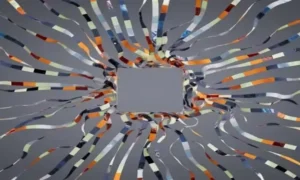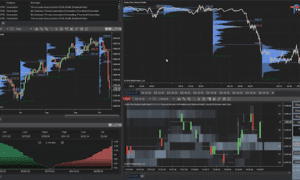An award-winning creative director on how design decisions can reduce emissions, shape behavior, and make sustainability part of everyday digital experiences.
On April 22, the world marks the 55th annual Earth Day, a global event that brings together individuals, organizations, and governments to support environmental protection. This year’s theme, “Our Power, Our Planet,” placed special emphasis on renewable energy, sustainability, and the urgent need for collective action. The problem touches all sectors, from activists and scientists to technologists, creatives, and business leaders.
To learn how to help the planet from behind the screen by designing products, interfaces, and visual systems, we spoke with Usevalad Abramau, a creative director and educator who believes that sustainability begins with design. With more than a decade of experience, collaborations with global brands such as BMW and PepsiCo, and an original methodology, he demonstrates how environmental awareness can be seamlessly integrated into digital practice without compromising aesthetic quality, meaning, or effectiveness.
Every Choice Adds Up
Many digital products—such as websites, apps, and online services—are developed primarily on appearance or ease of use. However, environmental impact is often overlooked in this process. For example, online grocery ordering platforms may not account for the amount of plastic used in packaging or consider the broader consequences of each order. While these design decisions may appear minor, when multiplied across thousands or millions of transactions, they can significantly affect the environment.
“One effective way to help is by rethinking how everyday tools and services function. Even a small adjustment, such as giving people the option to reduce packaging, can create significant environmental benefits at scale. When digital solutions are planned with long-term impact in mind, they can support more sustainable habits without requiring major changes in behavior. Thoughtful design has the power to make better choices easier and more accessible for everyone,” shares Abramau.
Usevalad put this principle into action while leading design at SberMarket, one of Eastern Europe’s largest e-commerce grocery platforms. He introduced a seemingly minor UX feature: a toggle allowing users to opt out of receiving extra plastic bags in grocery deliveries. This feature was simple, intuitive, and seamlessly integrated into the checkout process. Yet its impact was measurable and significant. According to internal data, 11% of users actively used the toggle, reducing over 2.3 million plastic bags annually. In addition to reducing waste, the feature sparked conversations within the company about embedding sustainability more deeply into its digital infrastructure. This decision marked a pivotal moment in the company’s development, demonstrating how environmentally conscious choices could align with business objectives and user expectations. The success of SberMarket’s initiative influenced broader industry thinking, helping spread the idea that small, well-placed design interventions can drive meaningful environmental change. It became a model for future eco-conscious features, showing that environmental responsibility can be naturally integrated into the everyday user experience without compromising convenience or performance.
Build Lighter, Impact Less
Although the internet may seem invisible, it has a tangible cost. Every time a website loads, energy is used—not just on the device, but across servers, networks, and data centers. This electricity often comes from fossil fuels, meaning each page view contributes to carbon emissions. Studies show an average web page produces around 0.8 grams of CO₂ per visit. That might seem small, but a site with 100,000 views per month adds up to nearly a ton of CO₂ per year—roughly the same as driving over 2,400 miles in a gasoline car. Multiply that by the billions of pages visited daily, and the environmental impact becomes impossible to ignore.
“Reducing the environmental impact of digital products begins with careful attention to what gets built and how it performs. Lightweight websites that avoid unnecessary visuals, animations, or third-party scripts consume less energy and place less strain on infrastructure. Designing with performance in mind—through smart image compression, efficient code, and minimalistic structure—can significantly lower emissions while improving usability. These choices, made early in the process, make digital experiences cleaner, faster, and more sustainable at scale,” says Abramau.
Usevalad put this idea into practice while overseeing the creation of a website platform designed to reduce energy consumption. The platform was engineered to reduce energy consumption through every layer of its design. A built-in filter automatically transformed images into bitmap-style graphics, cutting file sizes by up to 80%. This helped lower bandwidth usage and made websites load faster, even on older devices. The system included a tool that displayed real-time estimates of CO₂ emissions for each page, helping creators make informed design decisions. In early implementations, websites built on this platform used 30–50% less energy per pageview than comparable websites with standard visual content. Organizations utilizing the builder reported faster performance, reduced hosting costs, and a smaller digital footprint, demonstrating how performance-focused design can lead to measurable environmental gains.
Create Within Purpose
Eco-conscious design is often misunderstood as something that limits creative freedom. There’s a widespread assumption that focusing on sustainability means giving up visual richness, interactive features, or brand uniqueness. This belief creates hesitation, especially in industries where aesthetics, user engagement, and brand identity are top priorities. Research in design thinking suggests a different view. Dr. Katie Beverley of PDR emphasizes that setting environmental goals early in the creative process can open the way to stronger ideas. Working within meaningful boundaries helps generate clearer concepts, sharper storytelling, and more thoughtful design systems. Sustainability becomes a foundation for purposeful creativity.
Usevalad shares: “Strong design and environmental responsibility can reinforce each other. When creativity operates within meaningful limits—such as energy use or material waste—it yields smarter, more focused solutions. Thoughtful constraints can shape clearer messages, stronger visuals, and more memorable user experiences.”
At DD.NYC, a digital branding agency based in New York, Abramau led high-impact projects where sustainability became a central part of brand strategy. Environmental responsibility was treated as a creative strength that could enhance identity, user experience, and long-term value. He collaborated with clients across technology, wellness, and e-commerce sectors, helping them align their visual systems, content delivery, and development practices with low-impact principles. This included designing streamlined systems, improving performance through lightweight assets, and reducing reliance on energy-intensive features such as large media files or complex animations.
Each element was chosen with purpose: fonts that render efficiently, image formats that balance quality and speed, and layouts that minimize digital weight while preserving a clear brand voice. Several of these projects received international recognition, including the Webby Awards, Anthem Awards, CSS Design Awards, and ADC awards. These results showed how clarity, performance, and environmental care can work together to shape modern digital brands that meet rising public expectations and stand out through purpose-driven design.
Train Minds, Change Methods
Many designers enter the profession with strong technical skills and an eye for aesthetics, yet receive little guidance on how their work connects to environmental systems. In most traditional design programs, sustainability is rarely included in the core curriculum. As a result, professionals may create digital products that perform well visually, without realizing the long-term impact these products can have on energy use, digital waste, and ecological resources. Without access to relevant tools or frameworks, making informed choices that support creativity and environmental care becomes challenging.
Abramau says, “Design education plays a central role in shaping future practices. Introducing sustainability during training builds awareness, equips professionals with actionable strategies, and sets new expectations for how creative work serves the world. A strong foundation in ethical design encourages thoughtful habits that influence every stage of the creative process—from concept to deployment.”
Since 2021, Usevalad has taught sustainable digital design at institutions such as Synergy University, IGUMO, and the Institute of Photography, where his programs have reached more than 13,000 students. His curriculum combines environmental theory with practical design approaches, including energy-efficient interface planning, resource-aware user experience (UX) decisions, and methods for reducing digital clutter. Through lectures, hands-on workshops, and online courses, Usevalad has helped embed sustainability into the mindset of a new generation of designers. Many of his students have applied these principles in real-world projects, spreading the influence of his methodology across industries and countries.
His influence continues to grow through methodology, mentorship, and demonstrated results. Teams worldwide have adopted parts of his framework and integrated his thinking into their creative workflows. His approach demonstrates what is possible when sustainability becomes integral to the design process, creating clear paths for others to apply these ideas in practice.
As conversations around sustainability intensify, the role of design becomes increasingly defined. Decisions made early in the creative process significantly influence how people interact with services, the amount of energy digital systems consume, and the values embedded in everyday experiences. Design can guide behavior, reduce waste, and introduce clarity where complexity once ruled. In an era that demands responsibility across industries, even the most invisible aspects of digital work can leave a lasting impact on the future.





























